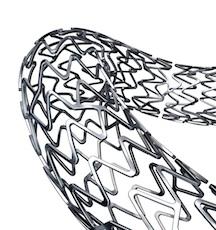
April 4, 2014 — A new stent covered with biodegradable coating continues to show statistical equivalence to Japan’s market leader in cumulative second-year data and subgroup analyses, according to research from the NEXT clinical trial presented at the American College of Cardiology’s 63rd Annual Scientific Session. NEXT is the largest head-to-head randomized study of these two stents — the novel biolimus-releasing model with the degradable coating (BES) Nobori stent from Terumo and and the everolimus-releasing standard with a durable polymer (EES) Xience stent from Abott Vascular.
Polymer coatings contain the drugs in drug-eluting stents, and slowly release agents to keep the stent clear of new lesions called intima neointima formations that lead to target lesion revascularization — a second procedure to restore blood flow to the blocked artery after a stent is in place. Drug-releasing stents have become standard treatment, but the permanent polymer that holds the helpful drug can cause late clinical problems.
First year results for 3,235 patients randomly assigned to BES (1,617 patients; 2,059 lesions) or EES (1,618 patients; 2,010 lesions) demonstrated statistically equivalent outcomes for the efficacy endpoint of target lesion revascularization and the composite safety endpoint of death from all causes and heart attack. The track record of non-inferiority continued with year-two data: BES 7.8 percent compared to EES 7.7 percent for safety endpoints; BES 6.2 percent compared to EES 6 percent for the efficacy endpoint. Landmark analysis at one year showed no difference in safety (BES 2.5 percent vs. EES 2.4 percent) or efficacy (BES 2 percent vs. EES 1.5 percent). Subgroup analysis for target lesion revascularization in patients with diabetes, insulin-treated diabetes, patients 75 years or older, hemodialysis, and multi-vessel angioplasty revealed no significant differences in cumulative incidence.
“Recent network meta-analyses suggested that drug-eluting stents with a biodegradable polymer had an excess risk for stent thrombosis or heart attack compared with second-generation everolimus stents with a durable coating,” said Masahiro Natsuaki, M.D., Kyoto University Graduate School of Medicine’s Cardiovascular Medicine Department. “However, we found no significant differences between the BES and EES groups. There was no apparent signal suggesting either improvement or impairment of clinical outcomes with one stent or the other.”
Natsuaki cautioned that underreporting of adverse events, especially stent thrombosis, is possible because study participants were not fully monitored. But angiograms in patients with target vessel revascularization were rigorously evaluated for blood clots at an angiographic core laboratory, and “adjudication of death and heart attack events was conducted very carefully” to rule out stent thrombosis, he said.
Because the BES biodegradable polymer takes up to a year to disappear, any differences in outcome between the two stent types will be evident only after the first year. “The advantage of polymer degradation and no permanent polymer in the vessel wall could emerge with longer-term follow up,” Natsuaki said. If year-three results confirm that outcomes with BES are at least equal to EES, patients with complex lesions requiring heart bypass surgery could be candidates for additional studies, he said.
The study was sponsored by Terumo Japan. Natsuaki indicated no conflict of interest.
This study will be simultaneously published online in the Journal of the American Medical Association at the time of presentation.
View the press conference.
For more: www.CardioSource.org


 April 24, 2024
April 24, 2024 








